 W
WCepheus is a constellation in the northern sky, named after Cepheus, a king of Aethiopia in Greek mythology.
 W
W9 Cephei, also known as V337 Cephei, is a variable star in the constellation Cepheus.
 W
W19 Cephei is a supergiant star in the northern circumpolar constellation of Cepheus. It has a spectral class of O9 and is a member of Cep OB2, an OB association of massive stars located about 615 parsecs (2,010 ly) from the Sun.
 W
WAlpha Cephei, officially named Alderamin, is a second magnitude star in the constellation of Cepheus near the northern pole. The star is relatively close to Earth at 49 light years (ly).
 W
WBarnard 150 is a dark nebula visible in Cepheus constellation. It is also known as the Seahorse Nebula due to its shape.
 W
WBeta Cephei is a triple star system of the third magnitude in the constellation of Cepheus. Based on parallax measurements obtained during the Hipparcos mission, it is approximately 690 light-years distant from the Sun. It is the prototype of the Beta Cephei variable stars.
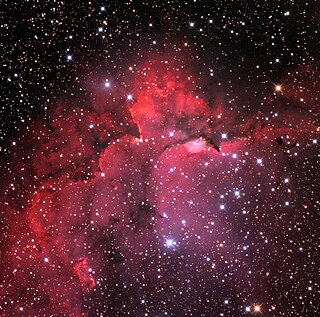 W
WCepheus OB1 is an OB association around the cluster NGC 7380. The region is approximately 3,400 parsecs from Earth in the constellation of Cepheus.
 W
WDelta Cephei is the Bayer designation for a quadruple star system located approximately 887 light-years away in the northern circumpolar constellation of Cepheus, the King. At this distance, the visual magnitude of the star is diminished by 0.23 as a result of extinction caused by gas and dust along the line of sight. It is the prototype of the Cepheid variable stars that undergo periodic changes in luminosity.
 W
WDH Cephei is a variable binary star system in the northern circumpolar constellation of Cepheus, positioned about two degrees to the east of the star system Delta Cephei. With an apparent visual magnitude of 8.61, it is too faint to be visible without a telescope. Based on parallax measurements, this system is located at a distance of approximately 10.6 kilolight-years from the Sun. At present it is moving closer to the Earth with a radial velocity of −33 km/s.
 W
WThe Elephant's Trunk Nebula is a concentration of interstellar gas and dust within the much larger ionized gas region IC 1396 located in the constellation Cepheus about 2,400 light years away from Earth. The piece of the nebula shown here is the dark, dense globule IC 1396A; it is commonly called the Elephant's Trunk nebula because of its appearance at visible light wavelengths, where there is a dark patch with a bright, sinuous rim. The bright rim is the surface of the dense cloud that is being illuminated and ionized by a very bright, massive star that is just to the east of IC 1396A. The entire IC 1396 region is ionized by the massive star, except for dense globules that can protect themselves from the star's harsh ultraviolet rays.
 W
WEta Cephei is a star in the northern circumpolar constellation of Cepheus. It shares the name Al Kidr with θ Cep, although the meaning of this name is unknown. With an apparent visual magnitude of 3.4, this is a third magnitude star that, according to the Bortle Dark-Sky Scale, is readily visible to the naked eye. Parallax measurements put it at a distance of 46.53 light-years from Earth.
 W
WThe Ghost Nebula is a reflection nebula located in the constellation Cepheus.
 W
WHD 204521 is a star in the northern constellation of Cepheus. In the sky it positioned just to the west of the magnitude 3.2 star Beta Cephei. This object has a yellow hue similar to the Sun but is too faint to be visible to the naked eye with an apparent visual magnitude of 7.26. It is located at a distance of 86 light years from the Sun based on parallax, and has an absolute magnitude of 5.15. The star is drifting closer with a radial velocity of −77 km/s, and is predicted to come to within 7.96 light-years in 334,000 years. At that distance the star can have a relatively small perturbing effect on comets in the Oort cloud.
 W
WHD 221525 is a single star near the north celestial pole in the constellation Cepheus. At an apparent magnitude of 5.56, it can be seen with the naked eye under dark skies. It is about 30 times fainter than the nearby prominent star Polaris. Based upon parallax measurements, HD 221525 is located at a distance of approximately 317 light years from the Sun, but is drifting closer with a radial velocity of −11 km/s.
 W
WThe Iris Nebula is a bright reflection nebula in the constellation Cepheus. The designation NGC 7023 refers to the open cluster within the larger reflection nebula designated LBN 487.
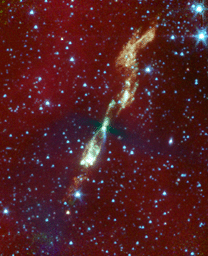 W
WL 1157 is a dark nebula in the constellation Cepheus. It was catalogued in 1962 by U.S. astronomer Beverly T. Lynds in her Catalogue of Dark Nebulae, becoming the 1157th entry in the table; hence the designation. The cloud contains an estimated 3,900 Solar masses of material. It includes protostars that are ejecting material in bipolar outflows, forming bow shocks in the surrounding ambient gas. Formamide and HCNO have been detected in these shocked regions, among other compounds.
 W
WLambda Cephei is a fifth magnitude blue supergiant star in the constellation Cepheus, one of the hottest and most luminous visible to the naked eye.
 W
WMu Cephei, also known as Herschel's Garnet Star, Erakis, or HD 206936, is a red supergiant or hypergiant star in the constellation Cepheus. It appears garnet red and is located at the edge of the IC 1396 nebula. Since 1943, the spectrum of this star has served as a spectral standard by which other stars are classified.
 W
WMY Cephei is a red supergiant located in open cluster NGC 7419 in the constellation of Cepheus. It is a semiregular variable star with a maximum brightness of magnitude 14.4 and a minimum of magnitude 15.5.
 W
WNGC 40 is a planetary nebula discovered by William Herschel on November 25, 1788, and is composed of hot gas around a dying star. The star has ejected its outer layer which has left behind a smaller, hot star with a temperature on the surface of about 50,000 degrees Celsius. Radiation from the star causes the shed outer layer to heat to about 10,000 degrees Celsius, and is about one light-year across. About 30,000 years from now, scientists theorize that NGC 40 will fade away, leaving only a white dwarf star approximately the size of Earth.
 W
WNGC 188 is an open cluster in the constellation Cepheus. It was discovered by John Herschel in 1825. Unlike most open clusters that drift apart after a few million years because of the gravitational interaction of our Milky Way galaxy, NGC 188 lies far above the plane of the galaxy and is one of the most ancient of open clusters known, at approximately 6.8 billion years old. NGC 188 is very close to the North Celestial Pole, under five degrees away, and in the constellation of Cepheus at an estimated 5,000 light-years' distance, this puts it slightly above the Milky Way's disc and further from the center of the galaxy than the Sun.
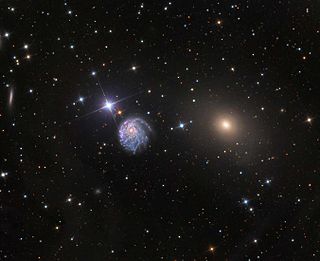 W
WNGC 2276 is an intermediate spiral galaxy in the constellation Cepheus. The galaxy lies 105 million light-years away from Earth. NGC 2276 has an asymmetrical appearance, most likely caused by gravitational interactions with its neighbor, elliptical galaxy NGC 2300. One of the many starburst spiral arms contains an intermediate mass black hole with 50,000 times the mass of the Sun, named NGC 2276-3c. NGC 2276-3c has produced two jets: a large-scale radio jet, approximately 2,000 light years long, and an "inner jet" about 6 light years long. The galaxy shows an enhanced rate of star formation that may have been triggered by a collision with a dwarf galaxy, or by the gravitational interaction with its neighbor compressing gas and dust.
 W
WNGC 2300 is a lenticular galaxy in the constellation Cepheus. It was discovered in 1871 by French astronomer Alphonse Borrelly using an 18 cm telescope.
 W
WNGC 6939 is an open cluster in the constellation Cepheus. It was discovered by William Herschel in 1798. The cluster lies 2/3° northwest from the spiral galaxy NGC 6946. The cluster lies approximately 4.000 light years away and it is over a billion years old.
 W
WNGC 6946 is a face-on intermediate spiral galaxy with a small bright nucleus, whose location in the sky straddles the boundary between the northern constellations of Cepheus and Cygnus. Its distance from Earth is about 25.2 million light-years or 7.72 megaparsecs, similar to the distance of M101 in the constellation Ursa Major. Both were once considered to be part of the Local Group. but are now known to be among the dozen bright spiral galaxies near the Milky Way but beyond the confines of the Local Group. NGC 6946 lies within the Virgo Supercluster.
 W
WNGC 6951 is a barred spiral galaxy located in the constellation Cepheus. It is located at a distance of about 70 million light-years from Earth, which, given its apparent dimensions, means that NGC 6951 is about 100,000 light-years across. It was discovered by Jérôme Eugène Coggia in 1877 and independently by Lewis Swift in 1878.
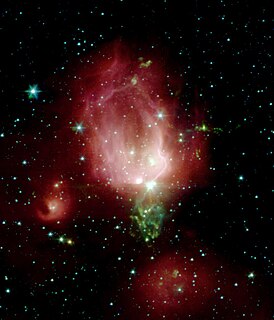 W
WNGC 7129 is a reflection nebula located 3,300 light years away in the constellation Cepheus. A young open cluster is responsible for illuminating the surrounding nebula. A recent survey indicates the cluster contains more than 130 stars less than 1 million years old. NGC 7129 is located just half a degree from nearby cluster NGC 7142.
 W
WNGC 7139 is a planetary nebula located in the constellation of Cepheus. It was discovered on November 5, 1787 by astronomer William Herschel.
 W
WNGC 7142 is an open cluster about 6,200 light-years away in the constellation Cepheus.
 W
WNGC 7160 is an open cluster in the constellation Cepheus. It was discovered by William Herschel on November 9, 1789. The cluster was also observed by John Herschel on October 7, 1829. It is a poor cluster and with little central concentration, with Trumpler class II3p. It is part of the stellar association Cepheus OB2, located one degree south-southwest of VV Cephei.
 W
WNGC 7354 is a planetary nebula located in the northern circumpolar constellation of Cepheus, at a distance of approximately 5.5 kly from the Sun. It was discovered by German-born astronomer William Herschel on November 3, 1787. John L. E. Dreyer described it as, "a planetary nebula, bright, small, round, pretty gradually a very little brighter middle".
 W
WNGC 7380 is a young open cluster of stars in the northern circumpolar constellation of Cepheus, discovered by Caroline Herschel in 1787. The surrounding emission nebulosity is known colloquially as the Wizard Nebula, which spans an angle of 25′. German-born astronomer William Herschel included his sister's discovery in his catalog, and labelled it H VIII.77. The nebula is known as S 142 in the 1959 Sharpless catalog (Sh2-142). It is extremely difficult to observe visually, usually requiring very dark skies and an O-III filter. The NGC 7380 complex is located at a distance of approximately 8.5 kilolight-years from the Sun, in the Perseus Arm of the Milky Way.
 W
WNGC 7419 is an open cluster in the constellation Cepheus. It is heavily reddened and notable for containing five red supergiants, the highest number known in any cluster until the end of the 20th century, but probably no blue supergiants.
 W
WNGC 7429 is an open cluster in the constellation Cepheus. The object was discovered on 29 September 1829 by the British astronomer John Herschel.
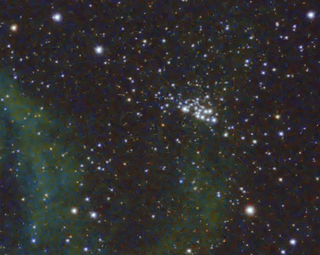 W
WNGC 7510 is an open cluster of stars located around 11,400 light years away in the constellation Cepheus, near the border with Cassiopeia. At this distance, the light from the cluster has undergone extinction from interstellar gas and dust equal to E(B – V) = 0.90 ± 0.02 magnitude in the UBV photometric system. Its brightest member is a giant star with a stellar classification of B1.5 III. This cluster forms part of the Perseus Spiral Arm. It has a Trumpler class rating of II 2 m and is around 10 million years old.
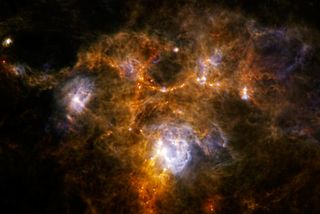 W
WNGC 7538, near the more famous Bubble Nebula, is located in the constellation Cepheus. It is located about 9,100 light-years from Earth. It is home to the biggest yet discovered protostar which is about 300 times the size of the Solar System. It is located in the Cepheus' Arm of the Milky Way and is probably part of the Cassiopeia OB2 complex. It is a region of active star formation including several luminous near-IR and far-IR sources. Stars in NGC 7538 are mainly low-mass pre-main-sequence stars.
 W
WNGC 7822 is a young star forming complex in the constellation of Cepheus. The complex encompasses the emission region designated Sharpless 171, and the young cluster of stars named Berkeley 59. The complex is believed to be some 800–1000 pc distant, with the younger components aged no more than a few million years. The complex also includes one of the hottest stars discovered within 1 kpc of the Sun, namely BD+66 1673, which is an eclipsing binary system consisting of an O5V that exhibits a surface temperature of nearly 45,000 K and a luminosity about 100,000 times that of the Sun. The star is one of the primary sources illuminating the nebula and shaping the complex's famed pillars of creation-type formations, the elephant trunks.
 W
WPalomar 1 is a globular cluster in the constellation Cepheus in the halo possibly in the Outer Arm of the Milky Way galaxy. First discovered by George O. Abell in 1954 on the Palomar Survey Sky plates, it was catalogued as a globular cluster. At 6.3 to 8 Gyr, it is a very young cluster when compared to the other globular clusters in the Milky Way. It is a relatively metal-rich globular with [Fe/H] = -0.60. It is likely that Palomar 1 has a similar evolutionary history to the Sagittarius dwarf companion globular Terzan 7, that is, it may have once been associated with a dwarf spheroidal galaxy that was later destroyed by tidal forces.
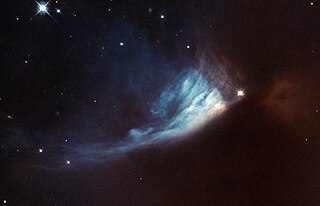 W
WPV Cephei is variable star of Orion type located in the constellation of Cepheus at a distance of over 1600 light-years from Earth. Although the terms 'Orion variable/Orion type' are now no longer used by most astronomers. The term 'Young Stellar Object' or YSO is preferred, since 'Orion Variable' is a term which was given at a time when these objects were thought to be more homogeneous than is now known to be the case. It has been used by the CGVS compilers but astronomers generally do not use these terms any more.
 W
WRW Cephei is a hypergiant variable star in the constellation Cepheus, at the edge of the Sharpless 132 HII region and close to the small open cluster Berkeley 94. One of the largest stars known, RW Cephei's radius is more than 1,000 times that of the Sun (R☉), thus larger than the orbit of Jupiter.
 W
WS5 0014+81 is a distant, compact, hyperluminous, broad-absorption-line quasar, or blazar, located near the high declination region of the constellation Cepheus, near the North Equatorial Pole.
 W
WSh2-155 is a diffuse nebula in the constellation Cepheus, within a larger nebula complex containing emission, reflection, and dark nebulosity. It is widely known as the Cave Nebula, though that name was applied earlier to Ced 201, a different nebula in Cepheus. Sh2-155 is an ionized H II region with ongoing star formation activity, at an estimated distance of 725 parsecs from Earth.
 W
WT Cephei is a Mira variable star in the constellation Cepheus. Located approximately 570 ± 40 light-years distant, it varies between magnitudes 5.2 and 11.3 over a period of around 388 days.
 W
WV354 Cephei is a red supergiant star located within the Milky Way. It is an irregular variable located over 8,900 light-years away from the Sun. It has an estimated radius of 685 solar radii. If it were placed in the center of the Solar System, it would extend to between the orbits of Mars and Jupiter.
 W
WV381 Cephei is a triple star system in the northern constellation of Cepheus. Its apparent magnitude is slightly variable between 5.5 and 5.7.
 W
WVV Cephei, also known as HD 208816, is an eclipsing binary star system located in the constellation Cepheus, approximately 5,000 light years from Earth. It is both a B[e] star and shell star.
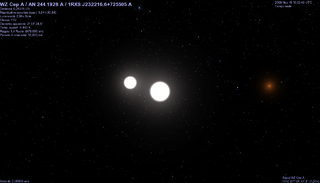 W
WWZ Cephei is an eclipsing binary star of W Ursae Majoris-type in the constellation of Cepheus, located 880 light years away from the Sun. The stars orbit around a common orbital barycenter every 0.41744 days. Timing analyses have revealed the possible presence of a third low-mass stellar companion in a wide orbit.
 W
WXi Cephei is a multiple star system in the constellation of Cepheus. It is approximately 86 light-years from Earth.
 W
WZeta Cephei is a star in the constellation of Cepheus. Zeta Cephei marks the left shoulder of Cepheus, the King of Joppa (Ethiopia). It is one of the fundamental stars of the MK spectral sequence, defined as type K1.5 Ib.